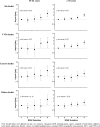Red blood cell distribution width and the risk of death in middle-aged and older adults
- PMID: 19273783
- PMCID: PMC2765040
- DOI: 10.1001/archinternmed.2009.11
Red blood cell distribution width and the risk of death in middle-aged and older adults
Abstract
Background: Red blood cell distribution width (RDW), a component of an electronic complete blood count, is a measure of heterogeneity in the size of circulating erythrocytes. In patients with symptomatic cardiovascular disease (CVD), RDW is associated with mortality. However, it has not been demonstrated that RDW is a predictor of mortality independent of nutritional deficiencies or in the general population.
Methods: Red blood cell distribution width was measured in a national sample of 8175 community-dwelling adults 45 years or older who participated in the 1988-1994 National Health and Nutrition Examination Survey; mortality follow-up occurred through December 31, 2000. Deaths from all causes, CVD, cancer, and other causes were examined as a function of RDW.
Results: Higher RDW values were strongly associated with an increased risk of death. Compared with the lowest quintile of RDW, the following were adjusted hazard ratios (HRs) for all-cause mortality (and 95% confidence intervals [CIs]): second quintile, HR, 1.1 (95% CI, 0.9-1.3); third quintile, HR, 1.2 (95% CI, 1.0-1.4); fourth quintile, HR, 1.4 (95% CI, 1.2-1.8); and fifth quintile, HR, 2.1 (95% CI, 1.7-2.6). For every 1% increment in RDW, all-cause mortality risk increased by 22% (HR, 1.22; 95% CI, 1.15-1.30; P < .001). Even when analyses were restricted to nonanemic participants or to those in the reference range of RDW (11%-15%) without iron, folate, or vitamin B(12) deficiency, RDW remained strongly associated with mortality. The prognostic effect of RDW was observed in both middle-aged and older adults for multiple causes of death.
Conclusion: Red blood cell distribution width is a widely available test that is a strong predictor of mortality in the general population of adults 45 years or older.
Figures
Comment in
-
Higher red blood cell distribution width was associated with increased risk of mortality in adults > or =45 years of age.Evid Based Med. 2009 Oct;14(5):151. doi: 10.1136/ebm.14.5.151. Evid Based Med. 2009. PMID: 19794026 No abstract available.
References
-
- Sategna Guidetti C, Scaglione N, Martini S. Red cell distribution width as a marker of coeliac disease: a prospective study. Eur J Gastroenterol Hepatol. 2002;14:177–81. - PubMed
-
- Spell DW, Jones DV, Jr, Harper WF, Bessman JD. The value of a complete blood count in predicting cancer of the colon. Cancer Detect Prev. 2004;28:37–42. - PubMed
-
- Anderson JL, Ronnow BS, Horne BD, et al. Usefulness of a complete blood count-derived risk score to predict incident mortality in patients with suspected cardiovascular disease. Am J Cardiol. 2007;99:169–74. - PubMed
-
- Felker GM, Allen LA, Pocock SJ, et al. Red cell distribution width as a novel prognostic marker in heart failure: data from the CHARM Program and the Duke Databank. J Am Coll Cardiol. 2007;50:40–7. - PubMed
-
- Tonelli M, Sacks F, Arnold M, Moye L, Davis B, Pfeffer M. Relation between red blood cell distribution width and cardiovascular event rate in people with coronary disease. Circulation. 2008;117:163–168. - PubMed
Publication types
MeSH terms
Grants and funding
LinkOut - more resources
Full Text Sources
Other Literature Sources




